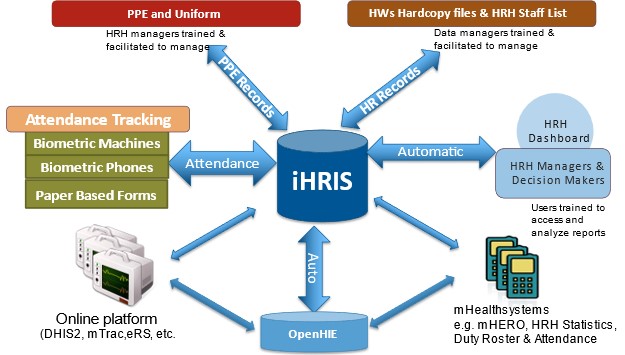Introduction
What is iHRIS?
The Integrated Human Resource Information System (iHRIS) is a free open-source software a web based computerized Human Resources management tool consisting of electronic databases for storing, analyzing and reporting data on Human Resources for Health (HRH) for evidence-based decisions on planning, managing, budgeting and policy shift in the health sector to improve access to services.
iHRIS is designed using Low/ Middle Income Countries (LMIC) use cases, highly customizable, Standards compliant, Global technical support community, Global Good, and adheres to Digital Development Principles.
iHRIS was designed with Interoperability with other systems in mind basing on OpenHIE Architecture and FHIR Compliancy at its core. It was developed so that it can work with other components of Health Information System (HIS) including OpenMRS, facility registries, DHIS2, and it is part of mHero.
iHRIS Architechture

iHRIS Framework
iHRIS is built on a flexible framework that allows ministries of health, professional councils, health training institutions, and health service delivery organizations to customize and adapt applications to meet a wide variety of needs for managing health workforce information.
Developed by IntraHealth International inc. in collaboration with national stakeholders beginning in 2005, with support from United States Agency for International Development (USAID), iHRIS is used in more than 20 countries to manage over a million health worker records at a potential cost savings of over $275 million when compared to commercial software.
iHRIS is simple, easy-to-use with a beautiful, fast and responsive interface for mobile or desktop, with a clean, modern look and feel that is easily customized and translated to support specific use cases. It enables health-sector managers and leaders to capture and maintain high-quality information for health workforce planning, management, training tracking, deployment, regulation, and mapping as illustrated in Figure 1. With this information on health worker numbers, biodata, skills, qualifications, locations, and more; nations can address health workforce shortages and solve other challenges across the health sector and beyond.

Implementation of iHRIS
Using iHRIS, HR professionals are able create a centralized information base on all human resource management aspects such as standard titles, job classifications and job descriptions spreading over geographic locations, offices, and facilities. HR managers can solicit job applications for open positions, assign employees to fill positions and maintain a searchable database of all employees, their identifying information and their qualifications; track each employee's history with the organization, including their position and salary histories, attendance to duty, and record the reason for departure.
iHRIS Use Framework
HRIS’s primary role is to manage workers employed through the FMOH at the ministry, regional, hospital, zonal, and woreda level. A decision maker within the organization is able analyze this data to answer key human resource management and policy questions, such as:
• Are employees deployed in positions that match their qualifications and education? • Are employees optimally deployed in locations to meet needs? • Are pay rates equitable across similar jobs? • How many workers need to be recruited to fulfill anticipated vacancies? • Are employees being promoted in alignment with competencies? • Are employees reporting for duty as per roster? • What are the reasons for employee attrition?
The iHRIS is an easy to use system that runs in clear roles for the HR managers and what users are expected to get from the system as illustrated below:
From the iHRIS use framework, all HRH records – health workers biodata, training information, registration and licensure details, deployment and employment history, health workforce planning and retention data, and health facilities details are kept in iHRIS. HRH managers update database with HRH data and all users including policy and decision makers make varying requests to get health workers profiles, reports and charts.
